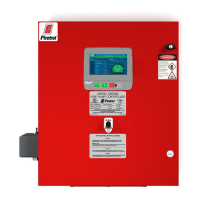3
Manual stop is done by pressing the STOP push button. Note that pressing the stop push button will stop the engine only if
all starting causes have disappeared.
The automatic stop is possible only after an automatic start and this function has been activated. When this function is
Enabled, the motor is automatically stopped 30 minutes (adjustable) after the restoration of the pressure (above the cut-out
threshold) given that no other run cause is present.
FLOW STOP, HIGH ZONE STOP
If the controller has been started by the FLOW/ZONE START/STOP input and the signal has returned to normal, the motor will
be stopped given that no other run cause is present.
The emergency stop is always possible in any running condition and is done by positioning the main selector -switch to the
Firetrol® FTA1100 combined automatic and manual diesel engine fire pump controllers are intended for starting and
monitoring fire pump diesel engines. They are available for use with 12 or 24 volt negative ground systems using lead acid
or Nickel-Cadmium batteries. FTA1100 fire pump controllers are listed by Underwriters Laboratories Inc., in accordance with
UL218, Standard for Fire Pump Control-lers, CSA, Standard for Industrial Control Equipment (cUL), and approved by Factory
Mutual. They are built to meet or exceed the requirements of the approving authorities as well as NEMA and the latest
editions of NFPA 20, Installation of Centrifugal Fire Pumps, and NFPA 70, National Electrical Code.
Except in some cases, the controller is also seismic approved and has been tested in accordance with the ICC-ES AC156, IBC
2015 & CBC 2016 standards. Proper installation, anchoring and mounting is required to validate this compliance report.
Refer to this manual and drawings to determine the seismic mounting requirements and location of the center of gravity (you
may need to contact factory). The equipment manufacturer is not responsible for the specification and performance of
anchorage systems. The structural engineer of record on the project shall be responsible for anchorage details. The
equipment installation contractor shall be responsible for ensuring the requirements specified by the structural engineer of
record are satisfied. If detailed seismic installation calculations are required, please contact the manufacturer for the
performance of this work.
FCC Regulations and Radio Standards Specification (RSS) Rules
To comply with FCC and Industry Canada RF exposure compliance requirements, a separation distance of at least 20 cm must
be maintained between the antenna of this device and all nearby persons. This device must not be co-located or operating in
conjunction with any other antenna or transmitter.
This device complies with Industry Canada licence-exempt RSS standard(s). Operation is subject to the following two
conditions: (1) this device may not cause interference, and (2) this device must accept any interference, including
interference that may cause undesired operation of the device.
This device complies with part 15 of the FCC Rules. Operation is subject to the following two conditions: (1) This device may
not cause harmful interference, and (2) this device must accept any interference received, including interference that may
cause undesired operation.
Note: This equipment has been tested and found to comply with the limits for a Class A digital device, pursuant to part 15 of
the FCC Rules. These limits are designed to provide reasonable protection against harmful interference when the equipment
is operated in a commercial environment. This equipment generates, uses, and can radiate radio frequency energy and, if
not installed and used in accordance with the instruction manual, may cause harmful interference to radio communications.
Operation of this equipment in a residential area is likely to cause harmful interference in which case the user will be
required to correct the interference at his own expense.
Installation

